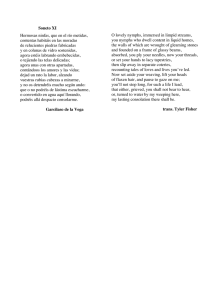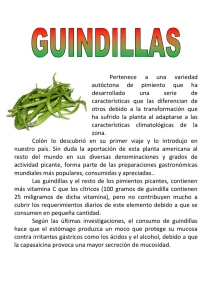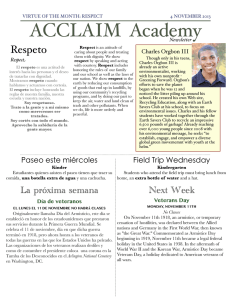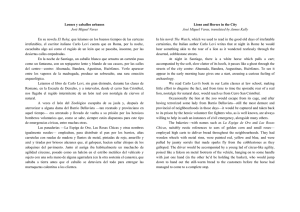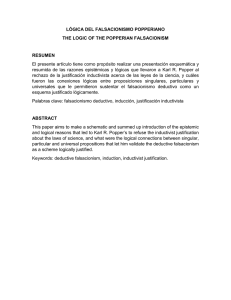Citi-sense WP5:
Anuncio
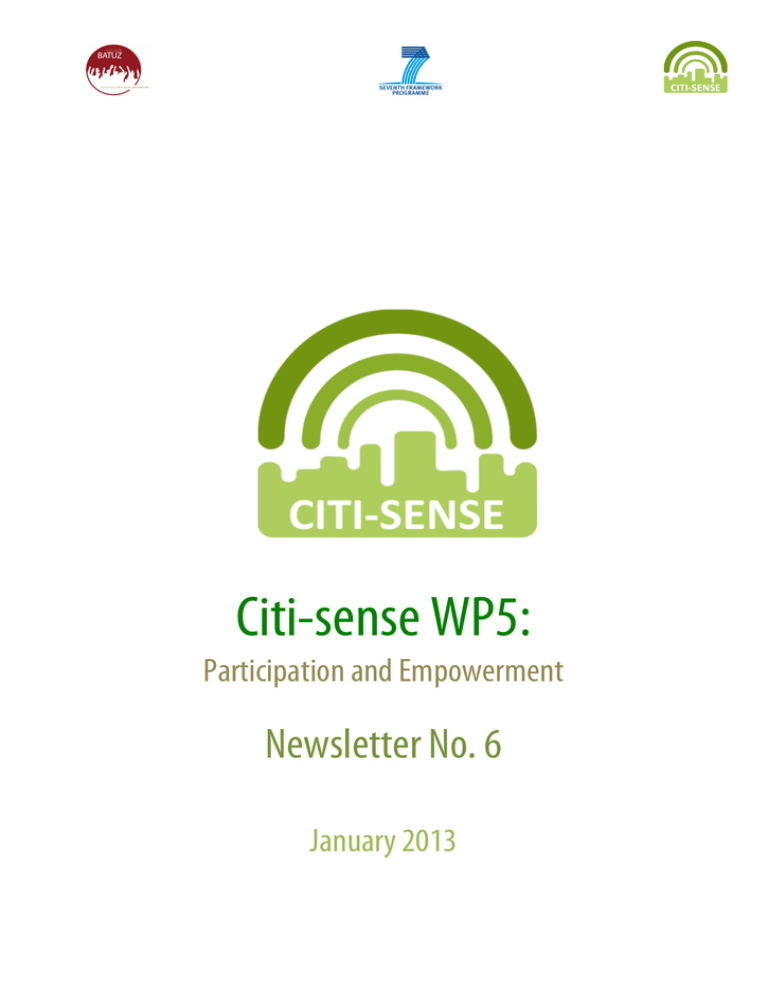
Citi-sense WP5: Participation and Empowerment Newsletter No. 6 January 2013 Articles and Publications. The Benefits of Citizen Engagement: a (Brief) Review of the Evidence. http://democracyspot.net/2012/11/24/the-benefits-of-citizen-engagement-a-brief-review-of-the-evidence/ What are the ingredients for community collaboration? When I first moved into local government I was sceptical that councils had the capability to be really innovative. Coming from a private sector background, I was labouring under the assumption that only the private sector could deliver efficient services. But I have now come to appreciate that local government not only has the capability but also the capacity to reform our public services. http://www.guardian.co.uk/local-government-network/2013/jan/21/localism-community-collaboration-lewes Las TIC y los múltiples lenguajes de la ciudad. Las barreras entre lo público y lo privado se desdibujan cuando en una plaza pública se transmiten datos personales a través del móvil, se comparte la ubicación con el círculo de amigos o se trasladan acciones solitarias propias del ámbito doméstico utilizando el ordenador portátil, la tableta o el smartphone. Las TIC han incluido nuevas capas digitales al entorno público de la ciudad cambiando la manera en que la utilizamos en nuestro día a día. […]El último número de Telos, coordinado por el antropólogo Néstor García Canclini, incluye también la investigación de Francisco Cruces acerca de la relación entre los ámbitos privados y la ciudad. El artículo recoge las conclusiones de los talleres realizados en Medialab-Prado y Lavapiés acerca de la ciudadanía como prosumidora, consumidora y a la vez creadora de contenidos en el espacio público a partir de sus móviles y portátiles. Por otro lado, Fernando Monge explora las nuevas cartografías que están creando los jóvenes incorporando las tecnologías digitales en su uso cotidiano de la ciudad, donde buena parte de la socialización se traslada a Internet. http://sociedadinformacion.fundacion.telefonica.com/seccion=1266&idioma=es_ES&id=2012102310540001&activo=6.do Put the citizens in the center of the board (To solve the smart city puzzle). 75 percent of global population will live in cities by 2050, according to statistics published by the Urban Age Project[1] for the London School of Economics and Deutsche Bank's Alfred Herrhausen Society.Growing at this pace, it is not surprising that the term “smart city” has become a trending topic and that sustainability and resource optimization are such pressing issues. Still, there’s a lot more to smart cities than sophisticated M2M (machine to machine) networks aimed at spending less and doing more. In order to be smart, a city needs a whole population of smart citizens. As Carlo Ratti from the MIT Senseable Lab usually says: “It’s not about technology, it’s about people”. http://abetterpeople.com/profiles/blogs/put-the-citizens-in-the-center-of-the-board-to-solve-the-smart#.UQdvtEojiM4 Citi-Sense Project Newsletter No.6 (January 2013) 2 Experiencies. Mapumental: el uso de datos públicos para elegir vecindario. La organización ciudadana MySociety ha lanzado el espacio Mapumental, una herramienta que ayuda a elegir donde vivir según variables de transporte público, belleza del entorno y precio del suelo. Aunque el mapa por ahora sirve sólo para Londres, es un ejemplo de uso social de la información pública y de los contenidos generados por la ciudadanía. http://www.euskadinnova.net/es/innovacion-social/noticias/mapumental-datos-publicos-para-elegir-vecindario/5368.aspx La fibra pretende transformar Ermua en un 'living lab' de las nuevas tecnologías. Entre algunas de las actividades experimentales de carácter sociosanitario que pueden ponerse en marcha a través de este medio se encuentran las dirigidas a las personas mayores o enfermas. Por ejemplo, «se podría contar con una agenda de ejercicios con vídeos, o una teleasistencia que le permita saber cuándo tomarse las píldoras», según Ruano, e incluso «apuntar los resultados médicos de las pruebas realizadas en casa para no tener que desplazarse al Centro de Salud o manteniéndose en contacto con el médico de cabecera en el caso de los enfermos crónicos». El responsable de incluir contenidos en la fibra óptica ermuarra también se mostraba optimista frente a la inclusión del concepto de 'hogar digital' «para compartir contenidos (fotos desde un móvil o la tablet y el televisor, sin tener que conectarse a nada...». Y puso especial énfasis en instalar «aplicaciones locales tales como un mercado de segunda mano de los habitantes de Ermua u otros». http://www.elcorreo.com/vizcaya/v/20130116/guipuzcoa/fibra-pretende-transformar-ermua-20130116.html Sociology of Courtyard Design: Lessons For Urban Public Places. Petr Ivanov is carrying out ambitious research in his Moscow neighborhood. He and a group of young volunteers have combined Web technology with social surveys to gather input from residents of four tall buildings around a woeful courtyard. The survey results will inform a redesign project aimed at improving this public space. http://sustainablecitiescollective.com/polis-blog/111831/sociology-courtyard-design-urban-public-space Make your street an open Street. If you think streets are for driving, you’re not alone. But you are also not thinking outside the box. Open Streets initiatives are taking root across the continent, with communities everywhere looking to use their streets for walking, dancing, bicycling, partying, and dozens of other activities that can help build healthier, stronger, more sustainable communities. Here are three ideas and resources from the Planning Tool Exchange to help you open your streets to more than just cars. http://opensource.com/life/12/12/make-your-street-open-street?sc_cid=70160000000IDmjAAG#.UMso6ZP3OvE.twitter The City at the Eye Level. A plinth is the ground floor facade of a building. It is a building’s most crucial part for the city at eye level. What do you as pedestrian experience when you look around? Are the buildings, their use and their design make an attractive urban environment where you feel at home? Do the plinths connect with pedestrian flows in the urban area? What are good functions for plinths? Which set of actions and partnerships are needed to transform dysfunctional plinths? The last few years, Stipo has worked on all kinds of plinth strategies: from the CityLounge programme in Rotterdam’s inner city to the transformation of Amsterdam’s ugliest into a welcoming street; from fashion in Arnhem’s Klarendal to better plinths in regeneration areas. Citi-Sense Project Newsletter No.6 (January 2013) 3 http://www.stipo.info/Artikel/Plinth_Strategy MIT researchers create new Urban Network Analysis toolbox. MIT researchers have created a new Urban Network Analysis (UNA) toolbox that enables urban designers and planners to describe the spatial patterns of cities using mathematical network analysis methods. Such tools can support better informed and more resilient urban design and planning in a context of rapid urbanization. “Network centrality measures are useful predictors for a number of interesting urban phenomena,” explains Andres Sevtsuk, the principal investigator of the City Form Research Group at MIT that produced the toolbox. “They help explain, for instance, on which streets or buildings one is most likely to find local commerce, where foot or vehicular traffic is expected to be highest, and why city land values vary from one location to another.” http://web.mit.edu/press/2011/urban-network-analysis.html http://cityform.mit.edu/ Congresses, Seminars, Courses, etc. #CeDEM13 Call for Paper: Conference for #EDemocracy and Open Government 2013. Transparency and access to information, new ways of interacting with government and democratic institutions, and Internet-based, decentralized grassroots activism have caused profound changes to the way states are run and society expected to function. Social media and new dimensions of online social activity, including individual and collective content generation, collaboration and sharing as well as the emergence of spontaneous multilevel networks change our understanding of how to run countries and companies. Services provided by public and private organisations have increased citizens’ independence and flexibility, but at the same time allow for more control. Now we have reached the point where we need to look at what the ideas, promises and suggestions have brought and why some projects have failed to reach the aims. Have aims and expectations been set too high? Or is the question how we define success (and failure)? Has the role of technology been overemphasised? These are some of the questions and topics we would like to discuss at the 2013 Conference. CeDEM13 critically analyses present and future developments in e-democracy and open government. http://www.donau-uni.ac.at/imperia/md/content/department/gpa/zeg/dokumente/cfp_cedem13.pdf The citizen side of Future Internet: Cities as Living Labs. Session description Citizens must play a clear role in the Future Internet design and construction. The cities as the place where people, infrastructures and services coincide, are the ideal place to experiment and explore new technologies, let users invent new uses of the technology and ways to improve it. Cities will become Living Laboratories of FI in the coming years. The session will explore how some cities that already started the process of enabling them as an extended and crowded experimental facility, are doing. The speakers will be experts involved in City Laboratories and extended Living Labs around the world. First of all, the session is of interest of city officials and innovation agencies that are willing to start programs to foster entrepreneurship and SMEs development as well as actively involving citizens in the process of technology adoption. In addition, technology companies interested in large scale testing and social open innovation processes should also be interested. The session will allow you to learn how to star the process to become a city laboratory, which are the other cities doing the same trip, which are the main difficulties to overcome and how other are solving them. https://osqa.eurescom.eu/questions/83/the-citizen-side-of-future-internet-cities-as-living-labs Citi-Sense Project Newsletter No.6 (January 2013) 4 Gaming the future of government. On January 22-23, the Institute for the Future will host Connected Citizens, a 24-hour collective forecasting game to “to rethink and reprogram government services for a complex and connected world.” The goal of Connected Citizens is to bring together people from around the world to rapidly generate as many forecasts, ideas and comments about civic technology and citizen engagement as possible in a 24-hour period. http://govfresh.com/2013/01/gaming-the-future-of-government/ Citi-Sense Project Newsletter No.6 (January 2013) 5
